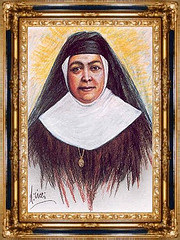
It was in 1874, in the midst of the industrial revolution. From that moment, she and the Jesuit Francisco Butinyà devoted themselves to helping poor women to make a decent living and discover their faith in everyday life.
The new order allowed the nuns to dress like the artisans of the country. There was no dowry asked of them to enter the convent, where they would work side by side with lay people. It was a project that did not please everyone.
Servant of Saint Joseph
“It was a life project that was too new for it to be understood. Still, some clergy of Salamanca don't understand it. They don't grasp how the gospel works in the project that's so close to the business world.”
As a result the bishop of Salamanca dismissed Mother Boniface and decided the order would be devoted to education. Boniface died being virtually excluded by her own order in 1905.
Years later, in 1936 her writings were rediscovered and the congregation again recognized her as the founder.
Sister Victoria López
Servant of Saint Joseph
“It's recognizing a charisma that was born in the heart of Nazareth. A charisma that is aimed at working women, poor women, women who are often abused, or underpaid, or deprived of liberty.”
The miracle that made her a saint took place in the Democratic Republic of Congo. It was the healing of a 33 year old man who suffered from an incurable stomach disease.
Sister Victoria López
Servant of Saint Joseph
“The entire world was waiting for it to die, but the community had begun to ask Mother Boniface for the healing of Kasongo Bavón. And inexplicably and unexpectedly, this boy was cured.”
Currently, the congregation of the Sisters of St. Joseph has around seven hundred sisters, working in one hundred communities in twelve countries. They are the successors of a simple working woman who had the courage to face the challenges of her time including being forced out of her order by those closest to her.

 RSS Feed
RSS Feed
